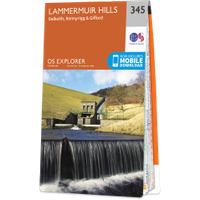Arniston House
Arniston House is largely an 18th century mansion house, however at its core is a much older tower house.
The estate on which it stands was once a royal hunting ground, which was granted to the Knights Templar early in the 12th century by David I. It was later made the barony of Balantrodoch or Balantrodach, and passed to the Knights Hospitaller following the outlawing of the Templars in the early 14th century.
Following the Reformation, Mary Queen of Scots sold the barony of Balantrodoch to James Sandilands, 1st Lord Torphichen and Preceptor of the Knights of St. John (ie the Knights Hospitaller), who later divided it up and sold the lands.
In 1571 Lord Torphichen sold off the section which would later become known as Arniston to George Dundas of Dundas Castle. He bought it as an inheritance for the eldest son from his second marriage, James Dundas.
George Dundas later bought some of the other portions of the barony of Balantrodoch, and added them to the estate which would start to be known as Arniston around this time.
It seems as though there was a tower house at Arniston when the Dundas family took over the estate, although it isn’t completely clear what kind of building it was. Late in the 16th century Arniston passed to James, later to become the Governor of Berwick, and it is said that he built a house and walled garden around 1620.
However, he and his family were certainly living at Arniston prior to this, so it’s possible that he actually remodelled and extended an earlier tower. The house that James Dundas built, the first to be known as Arniston House, was built on a U-shaped plan, and the central section between the two wings had massively thick walls and a vaulted basement.
This certainly suggests that there was a simple rectangular tower here before the 17th century, possibly dating to the 15th or 16th centuries, which was then either extended to a U-plan by James Dundas, or possibly even initially to an L-plan prior to George Dundas buying the estate.
The Dundas family became one of the most powerful families in Scotland, and by the late 17th century were something of a legal and political dynasty. When James’ grandson Robert Dundas, an MP and judge, died in 1726, Arniston was inherited by his son, also Robert.
The younger Robert Dundas was Solicitor General for Scotland, Lord Advocate, Dean of the Faculty of Advocates, and the Member of Parliament for Midlothian, and would later be Lord President of the Court of Session. He commissioned William Adam to extend and remodel Arniston on a grand scale, and work commenced in 1726.
Arniston is considered to be one of Adam’s most ambitious early works, a Vanbrugh-inspired baroque building. At its centre is a massive square hall, which occupies the old courtyard space within the older U-shaped house.
Behind this at the back of the house, and one level down, are two basement rooms with massively thick walls and vaulted ceilings, part of the original tower. Adam seems to have used the basic structure of James Dundas’ house, squaring off and filling in the U-plan to form a rectangular building.
But after 6 years, work stopped in 1732 as Dundas had run out of money. Arniston was left in a strange, unfinished state – the centre and east side were completed, as were the flanking pavilion to the east and west.
However the west side of the house was not finished, and with the wall that was supposed to link the west pavilion to the west side of the house already built, an unusual gap was left. The house remained like this until after the death of Robert in 1753, when his son, also Robert, inherited the estate and commissioned Adam’s son John to complete the house.
Robert’s daughter, Margaret Dundas, married General John Scott of Scotstarvit.
The house remained in the Dundas family, with the current owners styled Dundas-Bekker. A programme of restoration began in the 1970s, and further work was carried out in the 1990s. Interestingly John Adam’s section of the house would later suffer badly from dry rot, which was discovered in 1957 and finally restored in 1997.
Arniston House is now open to the public for limited tours during the summer months.
Alternative names for Arniston House
Arnestoun; Arnistoun; Old Arniston House
Where is Arniston House?
Arniston House is in the parish of Borthwick and the county of Midlothian.
Grid reference: NT 32589 59467
Lat / long: 55.823795, -3.077438












